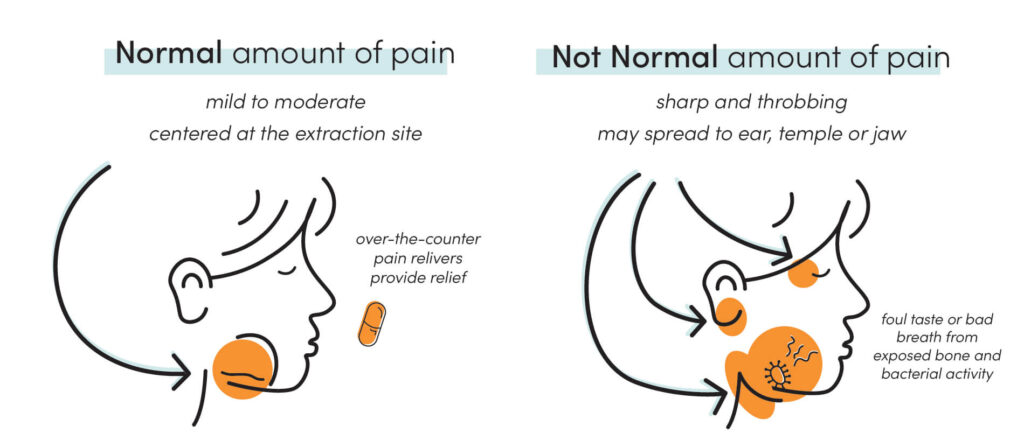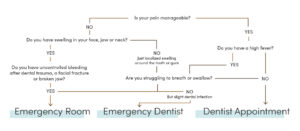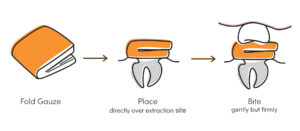Cómo saber si tiene alveolo seco: Explicación de los síntomas y signos claros

Revisado por Dr. Dennis Rollins, DDO |
Julio de 2025 - 6 min Leer
Reviewed By Dr. Dennis Rollins, DDO | Julio 2025 - 6 min Read
Las molestias y la hinchazón tras una extracción dental no significan necesariamente que tenga un alveolo seco. A continuación encontrará la orientación que ofrecemos a los pacientes cuando nos preguntan cómo diferenciar entre los signos de un alveolo seco y los síntomas postextracción normales.
Empezaremos con una guía rápida. Si sus síntomas coinciden con los de la columna central, puede estar seguro de que su recuperación postextracción progresa con normalidad.
Cómo interpretar el dolor tras una extracción dental
Es normal sentir algo de dolor justo después de una extracción. Suele ser de leve a moderado y centrado en el lugar de la extracción. Los analgésicos de venta libre suelen proporcionar un alivio adecuado, y el dolor debería disminuir gradualmente durante los primeros días.
El dolor causado por una alveolitis seca es mucho más intenso. Es agudo y punzante, y puede extenderse a la oreja, la sien o la mandíbula. Además, en lugar de mejorar, suele intensificarse entre dos y cuatro días después de la intervención. Si esta descripción se ajusta a sus síntomas, es importante que se ponga en contacto con su dentista lo antes posible. Un tratamiento precoz puede aliviar las molestias y devolverle a la vía normal de curación.
Haga clic en aquí para encontrar un dentista cerca de usted
“Si usted piense en tienes un alveolo seco, no lo tienes”, escribió un paciente en reddit.com. “Te lo dice alguien que ha tenido un alveolo seco dos veces. No confundirás el dolor con otra cosa que no sea un alveolo seco”.”
A continuación, tranquilizan sobre la eficacia del tratamiento, señalando que “aunque te contagies, con el tiempo estarás bien”.”
“Experimenté un dolor intenso a partir del cuarto día después de la extracción”, informó otro paciente en azoralsurgery.com. “El malestar era diferente a cualquier dolor de muelas típico que he tenido antes. Mi dentista aplicó un apósito medicado, que proporcionó un alivio significativo.”

Las apariencias engañan
Después de la extracción, es posible que notes una zona blanquecina en el lugar de la extracción. Puede tratarse de hueso expuesto, lo que puede indicar una alveolitis seca, sobre todo si hay otros síntomas, como dolor intenso, mal aliento o retraso en la cicatrización.
Sin embargo, la zona blanquecina también puede formar parte del proceso normal de cicatrización, a medida que crece nuevo tejido sobre la zona de extracción.
Por lo tanto, ver el hueso blanco no significa necesariamente que haya una alveolitis seca. Por otra parte, es posible tener una cuenca seca sin ver hueso. Puede parecer que el coágulo de sangre está en su sitio, pero sigue dejando espacio para que el aire y los alimentos entren en la cavidad.
En resumen, observar el lugar de extracción puede ser útil, pero es importante prestar atención a los otros síntomas potenciales enumerados anteriormente.
Reducir el riesgo de enchufe seco
Para evitar la sequedad del alveolo después de una extracción dental, siga al pie de la letra las instrucciones de su dentista. Durante la recuperación, evite fumar, beber alcohol y beber con pajita. Cepíllate los dientes y usa hilo dental con regularidad pero con cuidado, manteniéndote alejado de la zona de la extracción. Mantenga la zona limpia con enjuagues suaves de agua salada después del primer día y coma alimentos blandos y ricos en nutrientes.

Qué hacer si sospecha que tiene un calcetín seco
Llama inmediatamente a tu dentista y concierta una cita. Por lo general, limpiarán suavemente la zona, colocarán un apósito medicamentoso y te ayudarán a aliviar el dolor mientras se cura la zona de la extracción.
Mientras espera la cita, puede hacer algunas cosas en casa para aliviar las molestias y proteger la zona:
- Tome analgésicos sin receta, a menos que su dentista le haya aconsejado lo contrario.
- Aclarar muy suavemente con agua salada tibia para mantener la zona limpia.
- Coloque una compresa fría en la parte exterior de la mejilla para aliviar el dolor y la inflamación.
- Siga evitando el tabaco, el alcohol y las pajitas, ya que pueden empeorar la afección.
- Limítate a los alimentos blandos y suaves, como el yogur, el puré de patatas o los batidos sin semillas ni trozos de fruta.
- Cuando esté tumbado, mantenga la cabeza ligeramente elevada para aliviar el dolor y ayudar a reducir la presión sanguínea en la zona.
Ninguna de estas medidas curará la alveolitis seca, pero pueden controlar los síntomas hasta la cita con el dentista.
¿Se cura solo un calcetín seco?
Sí, un alveolo seco suele curarse sin tratamiento, pero puede tardar semanas. El dolor suele ser intenso y puede interferir en la alimentación, el sueño y la vida diaria. Además, dejar un alveolo seco sin tratar aumenta el riesgo de infección.
Acudir al dentista acelera considerablemente la curación. Muchos pacientes se sienten mejor a las 24-48 horas del tratamiento, aunque la curación completa suele tardar una semana.
Emociones y ansiedad tras una extracción
Es habitual y normal sentir cierto malestar durante la recuperación. La incomodidad y la incertidumbre pueden ser inquietantes. Aunque es importante estar atento a los signos de alveolitis seca, recuerde que la mayoría de las extracciones se curan sin problemas. E incluso si se desarrolla un alveolo seco, es temporal, tratable y no peligroso cuando se trata con prontitud.
Si te pone nervioso que te traten una alveolitis seca, considera la posibilidad de buscar un dentista que ofrezca opciones que no provoquen ansiedad, como óxido nitroso (gas hilarante), pastillas sedantes orales o incluso sedación intravenosa.
En caso de duda, no dude en consultar a su dentista. Su tranquilidad y su capacidad para descansar son importantes para su recuperación.
¿Necesita ayuda para cuidar un enchufe seco?
Información relacionada

¿Cuánto cuesta una visita al dentista sin seguro? Costes exactos
A continuación encontrará un desglose de los gastos de bolsillo típicos de los procedimientos dentales más comunes, junto con las razones que los justifican. Tenga en cuenta que estos costes pueden variar significativamente en función de su ubicación, la experiencia del dentista, los materiales utilizados y la complejidad del procedimiento.

¿Debe acudir a urgencias por dolor de muelas? Guía rápida
La conveniencia de acudir a urgencias por dolor de muelas depende de la gravedad del dolor y de los demás síntomas que experimentes. Sigue leyendo y te ayudaremos a decidir cómo aliviarte.

Cómo detener el sangrado después de la extracción del diente: Consejos fáciles para un alivio inmediato
Tras la extracción de un diente, es normal que se produzca una hemorragia en la zona, que suele remitir en 2-3 horas. Durante las primeras 24 horas suele seguir supurando suavemente (saliva rosada). A continuación encontrarás consejos para ayudar a detener la hemorragia y cómo diferenciar entre una recuperación normal y los signos que indican que debes llamar a tu dentista.
